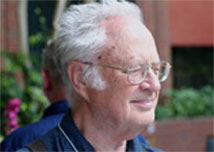
Dr. Barry Clark

Dr. Barry Clark
The 2009 Grote Reber Gold Medal for lifetime innovative contributions to radio astronomy has been awarded to Dr. Barry Clark, an Emeritus Scientist at NRAO in Socorro, New Mexico. Clark is being honored for his many pioneering developments to radio interferometry and synthesis imaging, over a career spanning more than half a century. Throughout his career Barry has tackled the most difficult problems, leaving the easy ones for others. Although he is known as a man of few words, Dave Jauncey a long time colleague commented that these words "were most certainly worth listening to!"
Barry received his B.S. and Ph.D. degrees in astronomy from Caltech and MIT in 1959 and 1964 respectively. His scientific career has extended over a half-century starting with his research on the solar corona and the Galactic magnetic field while still an undergraduate at Caltech. As a graduate student, Barry used the Caltech radio interferometer to study Galactic atomic hydrogen clouds, and suggested that interstellar hydrogen is found in two distinct temperature phases — thus leading to our current understanding of the multiple phases of the interstellar medium.
After receiving his Ph.D. in 1964, Barry came to NRAO where he has remained through the present. Soon after he arrived at NRAO, he led the development of the world's first digital recording, software correlator interferometer system and the subsequent enhancements to its sensitivity. He is probably best known, however, as the intellectual power behind the Very Large Array (VLA). Later, he led the design of the Very Long Baseline Array (VLBA).
The 2009 Reber Medal will be presented to Barry Clark on 5 August at the meeting of the International Astronomical Union in Rio de Janeiro, Brazil. The Reber Medal was established by the Trustees of the Grote Reber Foundation to honor the achievements of Grote Reber and is administered by the Queen Victoria Museum in Launceston, Tasmania. Nominations for the 2010 Medal may be sent to Martin George, Queen Victoria Museum, Wellington St, Launceston, Tasmania 7250, Australia or by e-mail to: martin@qvmag.tas.gov.au to be received no later than 15 November 2009.